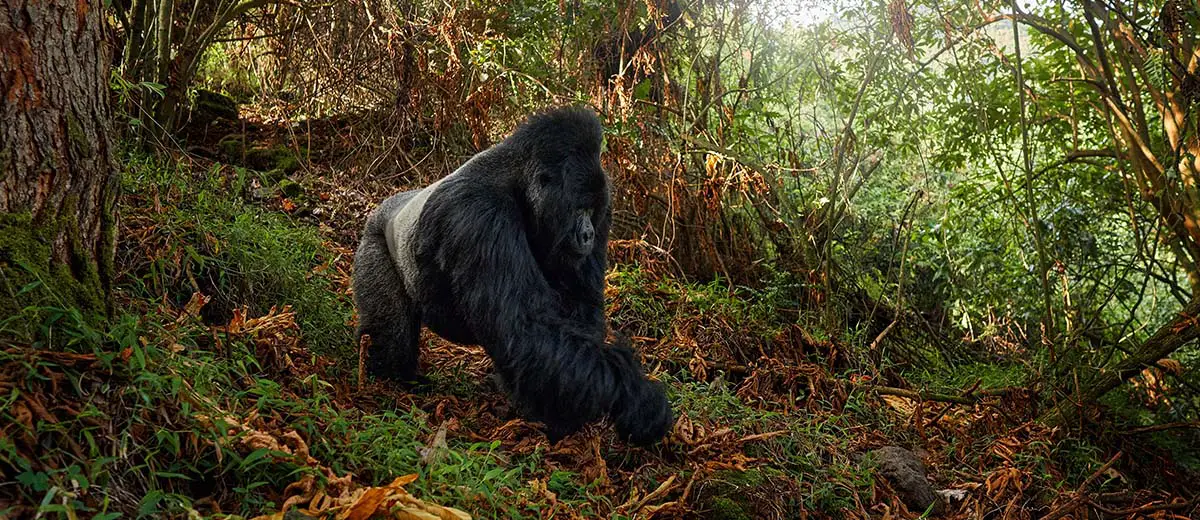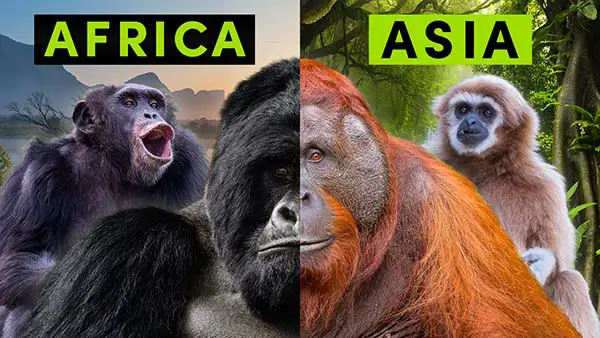All 4 Non-Human Apes – A Detailed Comparison
As our closest relatives, apes are some of the most fascinating creatures on earth. In total, there are 27 species of ape, which include chimpanzees, bonobos, gorillas, orangutans and gibbons. In addition to the obvious differences in physical appearance, there are many elements that make each of these types of animals quite unique and interesting. In this article, we’ll compare the four different types of apes from their behavioural tendencies and reproduction to physical characteristics and location. Let’s dive in!
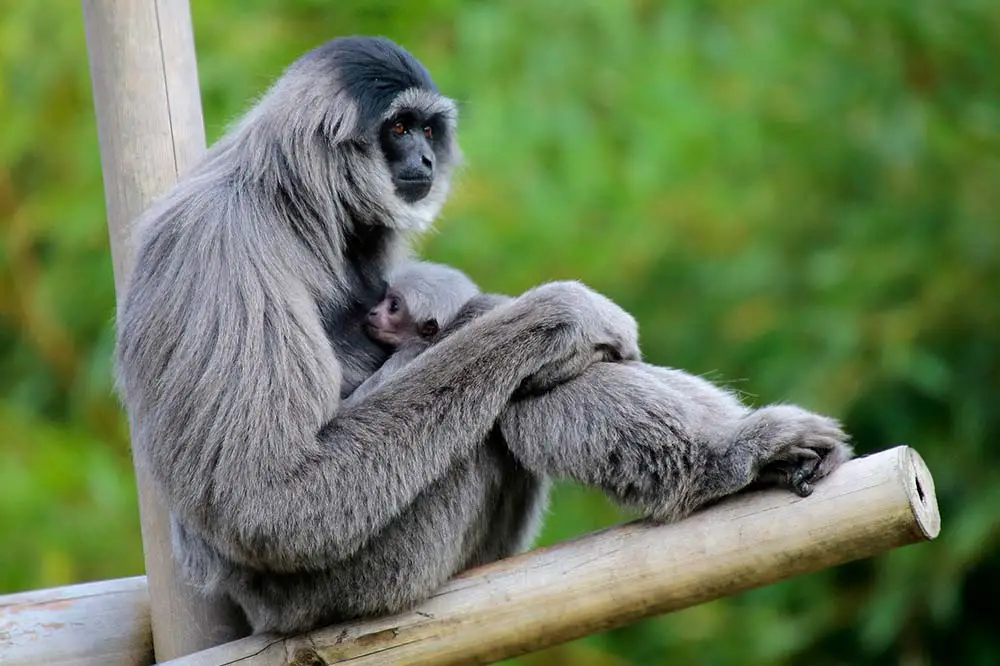
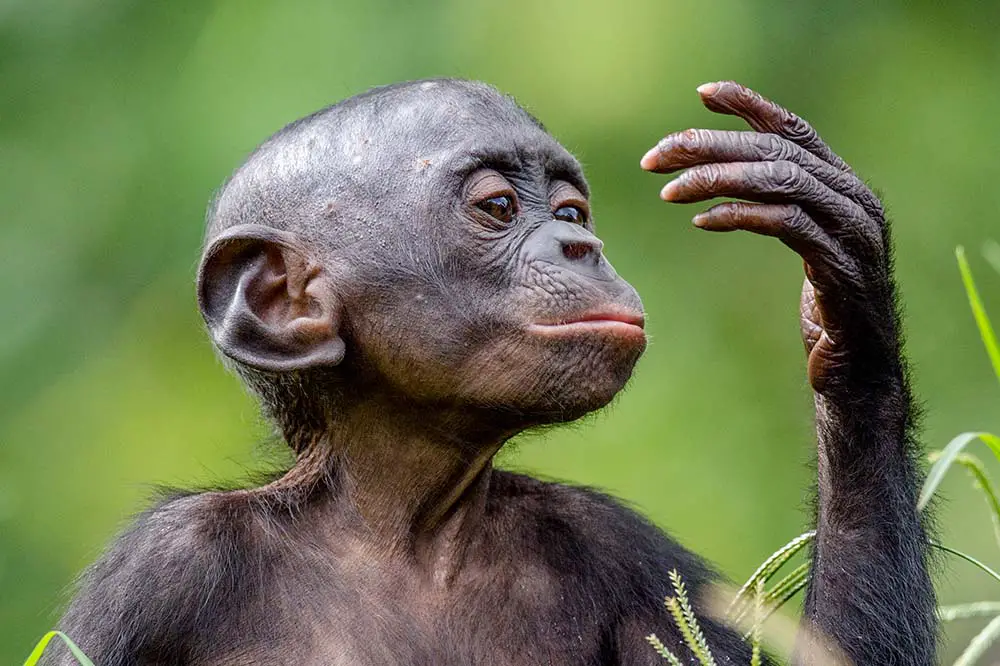
Left: Silvery gibbon with baby / Shutterstock & Right: Baby Bonobo / Shutterstock
Contents
- Reproduction & Life Span/Cycle
- Taxonomy, Location, Population & Conservation
- Physical Characteristics
- Ecology, Diet & Movement
- Behaviour
Reproduction & Life Span/Cycle
Chimpanzees and bonobos are born after a gestation period of 8 months and, sharing a powerful bond with their mother, will cling to her chest for the first 6 months. The baby is then carried on its mother’s back until around 2 years of age but will not become fully weaned until 4 or 5. Independence occurs after 7-9 years but chimpanzees won’t reach sexual maturity until 13 for females and 15 for males. Upon reaching maturity, females will venture off to find another community, preventing inbreeding, whereas males will stay with theirs for life. Chimps live for 40-50 years in the wild and an adult female gives birth once every 5 years.
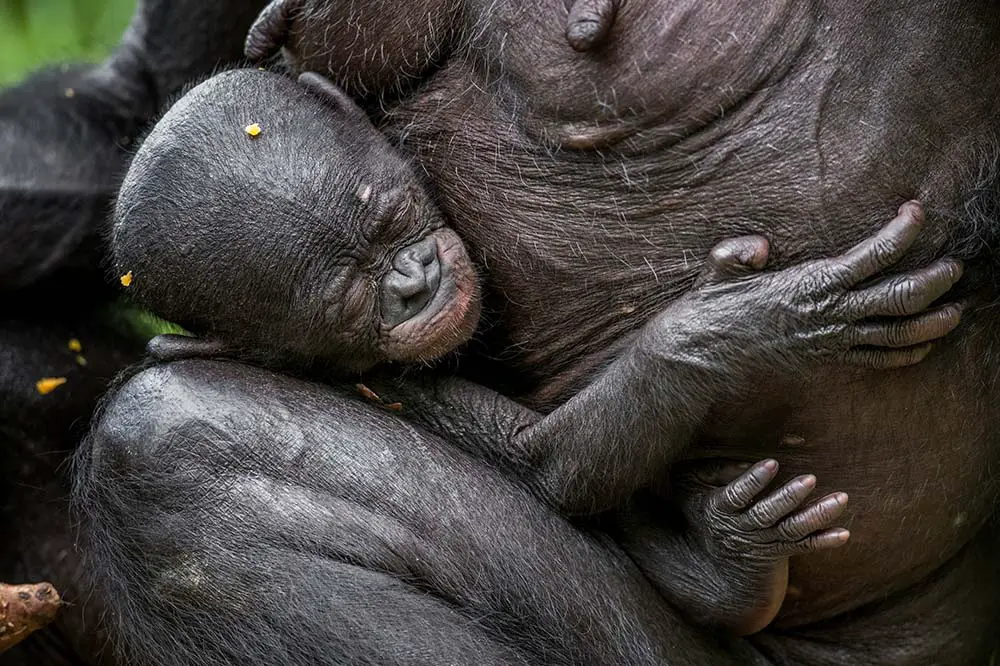
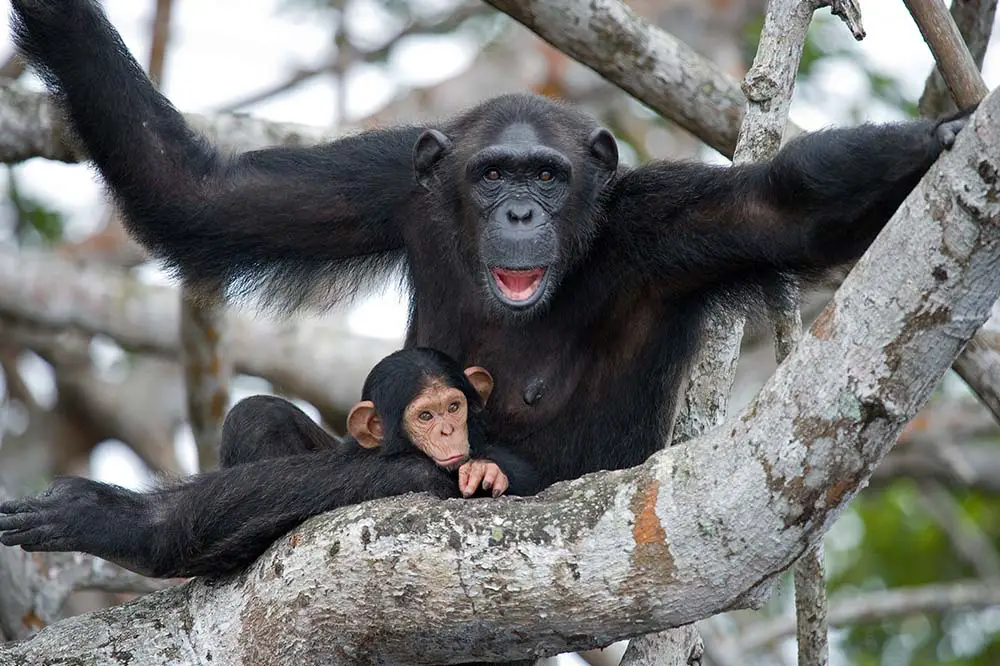
Left: Baby bonobo clinging to mother’s chest / Shutterstock & Right: Baby chimpanzee hanging with mum / Shutterstock
The reproductive cycle of a gorilla is shorter, producing offspring every four years after a slightly longer gestation period of 8.5 months. Like chimpanzees, gorilla offspring are helpless when born and cling to their mother’s chest until around 4 months old. At this point, a young gorilla will ride on its mother’s back until around 2-3 years of age. Independence is reached after just 3-4 years but sexual maturity takes 10 for females and 15 for males. Gorillas will also live for 40+ years in the wild but with this species, it is usually the males who leave to establish new troops. Some males will stay, however, and queue for dominance of the troop, which some take over from their father.
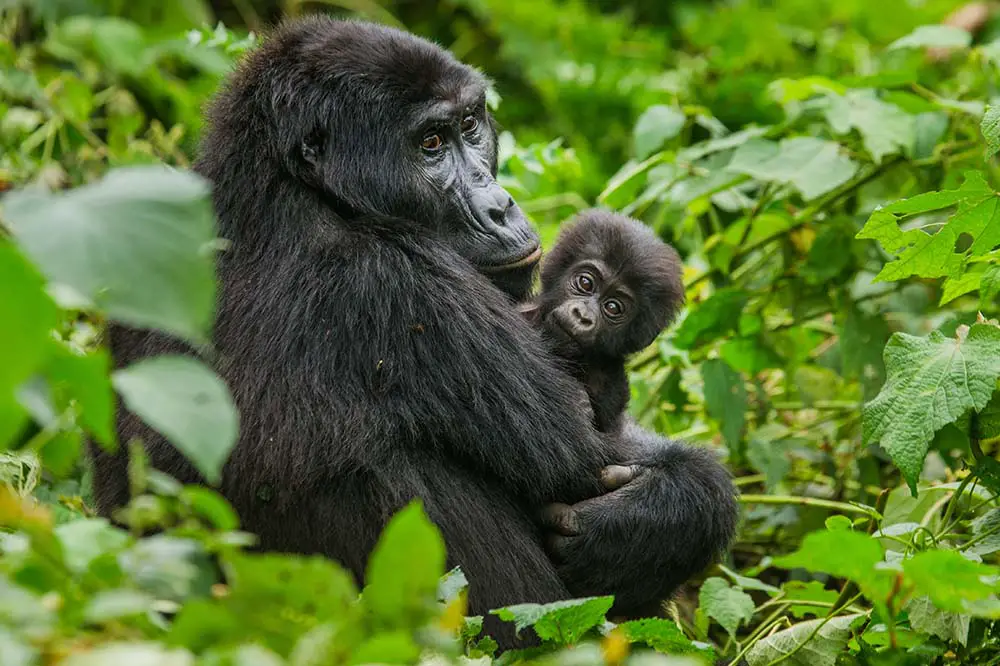
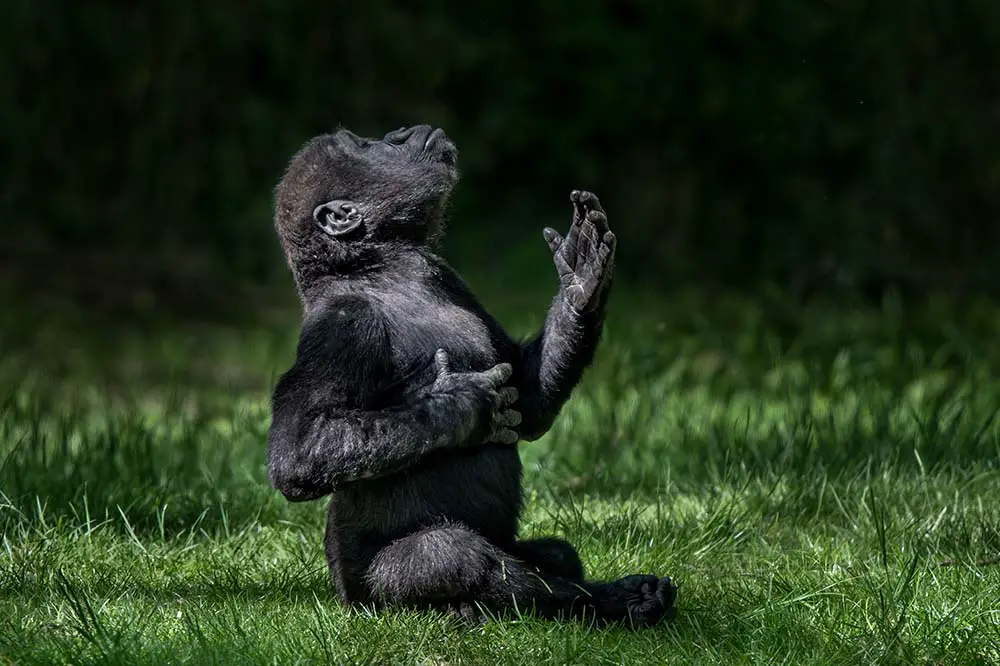
Left: Baby gorilla with mother / Shutterstock & Right: Young gorilla / Shutterstock
Lifespan is a similar story for orangutans at 35-40 years but their reproductive cycle is quite different to that of the African apes; at 8 years, they have the longest interbirth interval of any land mammal, meaning females usually have no more than 3 babies during their lifetime. Gestation is around the same as a gorilla at 8.5 months and like the other great apes, their offspring, who have white patches on their face and bodies, will be carried everywhere by their mother for the first 4 months and will remain by her side until 6-8 years of age. Sexual maturity depends on gender and species and can range anywhere from 6 to 11 years for Bornean females all the way up to 15 to 24 years for Sumatran males.
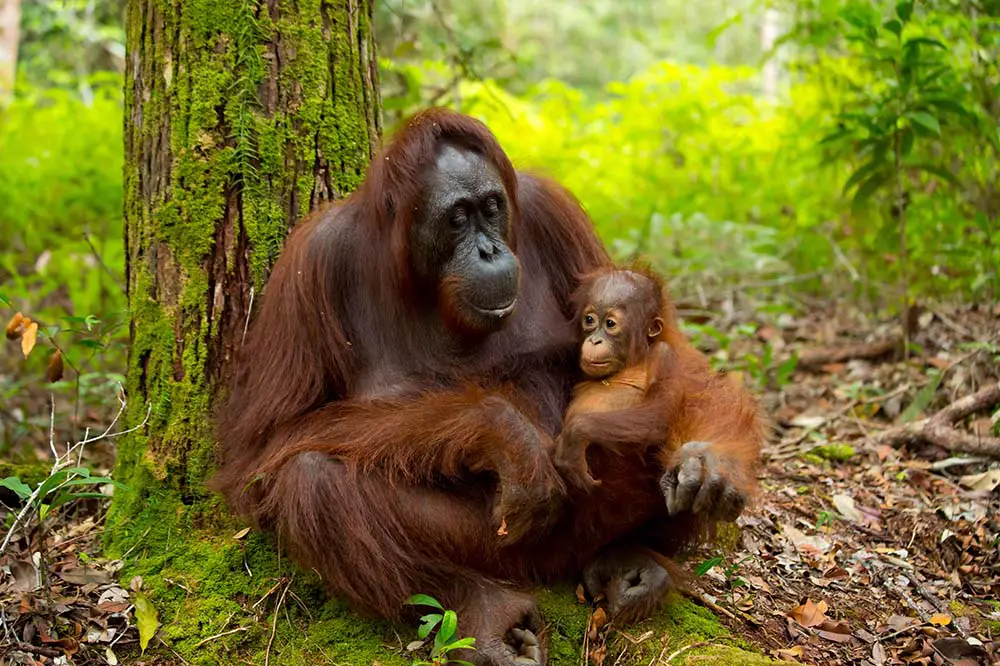
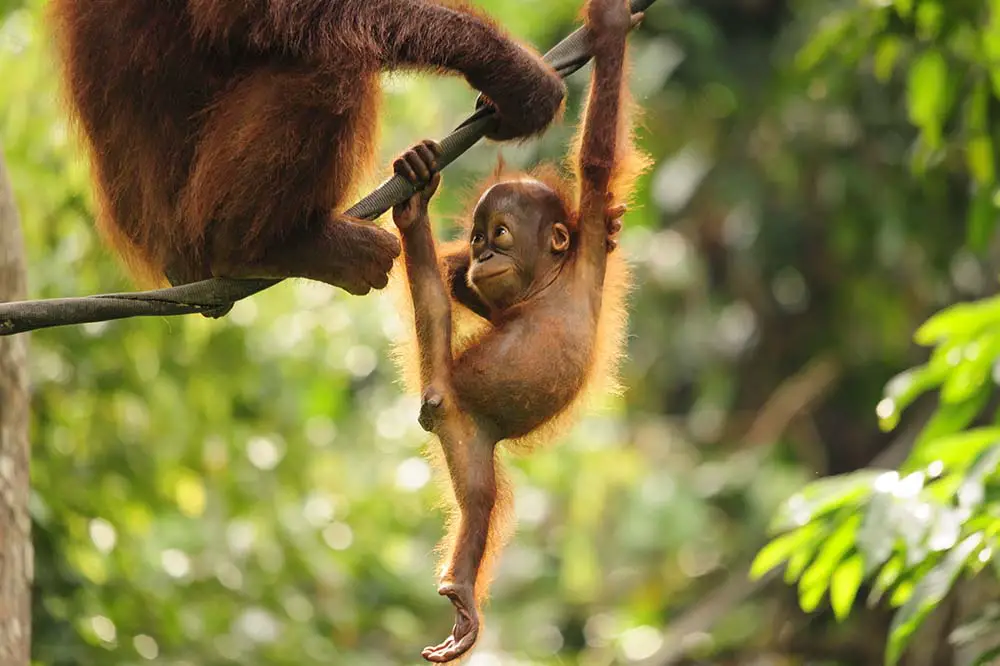
Left: Proud mother orangutan / Shutterstock & Right: Baby orangutan climbing / Shutterstock
The life cycle of a gibbon is also quite different from other apes. Gibbons produce offspring every 2-3 years normally bearing a single child after a shorter gestation period of around 7 months. Depending on species, weaning is usually complete within 18 to 24 months, around half that of the great apes but independence is still not reached until 6 to 8 years of age when they will leave their family unit to start their own. The lifespan of a gibbon is also shorter than that of the great apes at around 25-30 years.
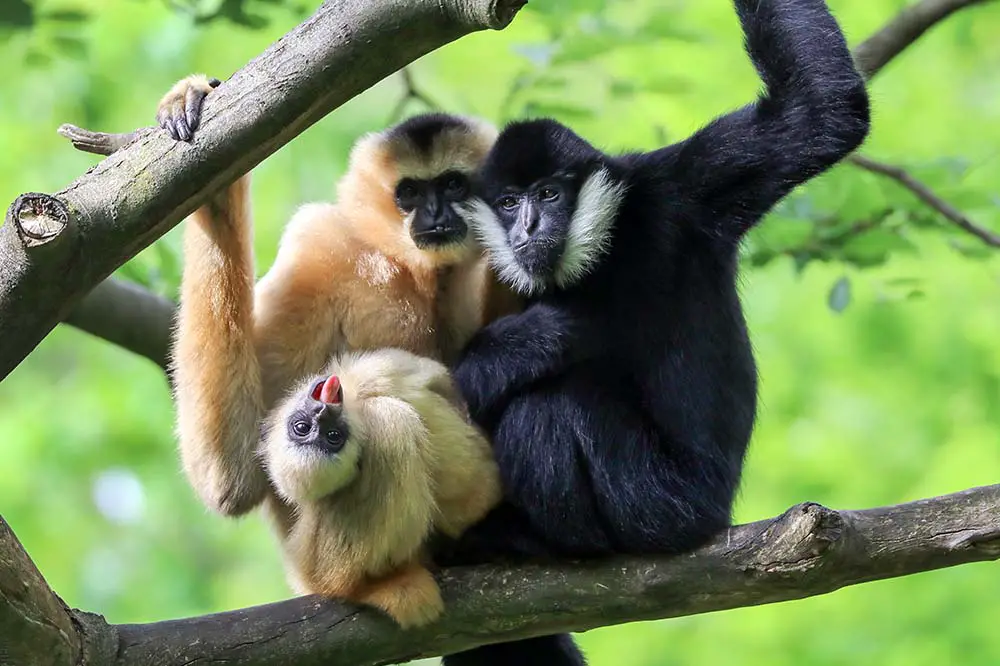
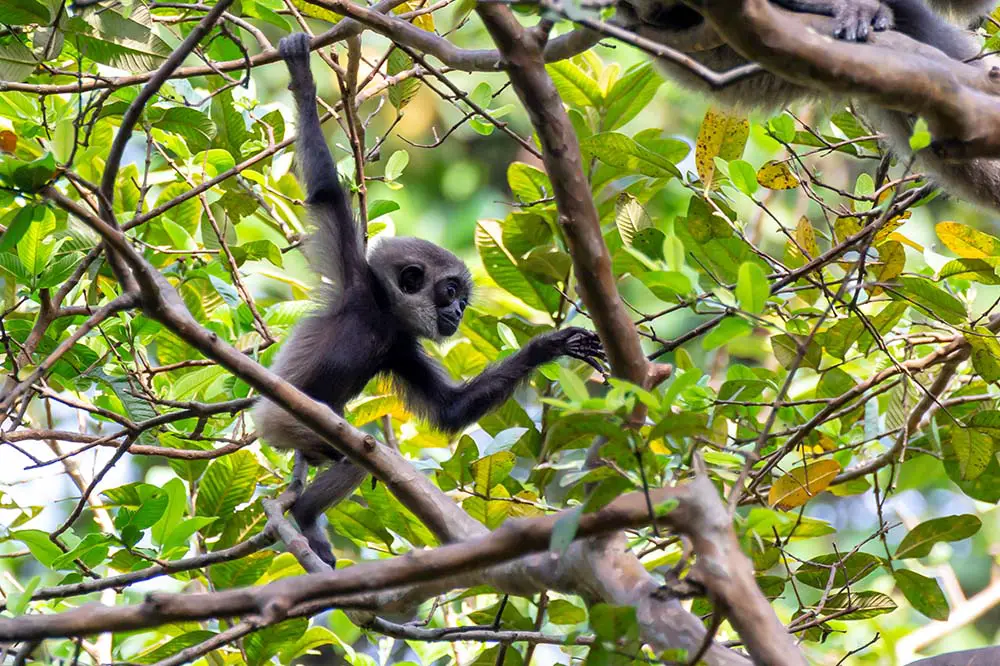
Left: Yellow cheeked gibbon family / Shutterstock & Right: Baby silvery gibbon / Shutterstock
Taxonomy, Location, Population & Conservation
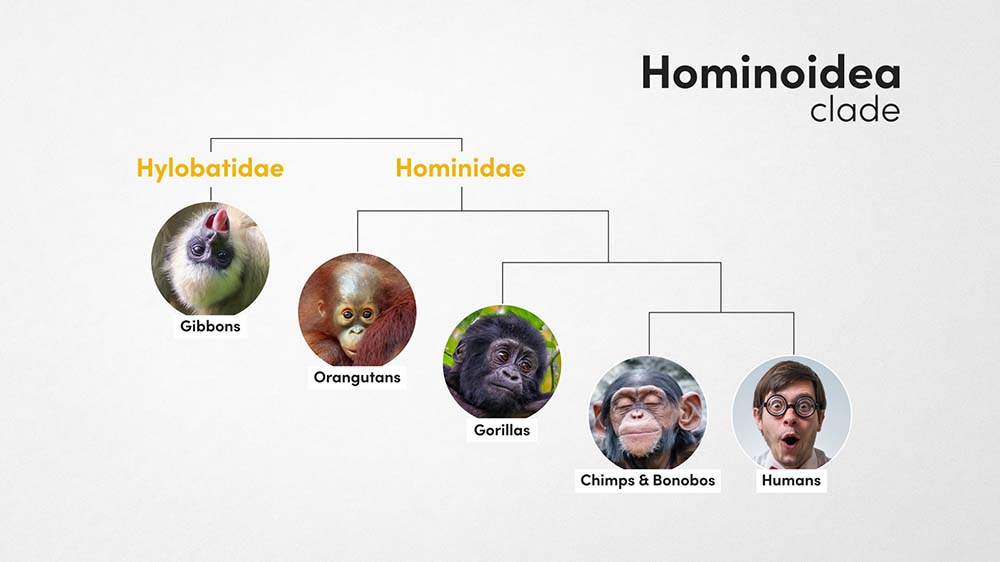
Gibbons are classed as lesser apes and are found in a separate family to the greater apes, Hylobatidae. It is by far the most diverse group of apes with 20 of the 27 species being found within this family. Most of their population is found on mainland Southeast Asia but like orangutans, are present on the islands of Borneo and Sumatra. Their range is split geographically between their four genera with the range of hylobates overlapping with that of the monotypic.
Of the 20 species of gibbon, 1 has a conservation status of vulnerable, 14 are endangered and a further 5 are critically endangered. Some of the species most at risk are the newly discovered Skywalker hoolock gibbon, with just 150 individuals and the eastern black crested gibbon, who number no more than 50. Like other apes, poaching and habitat destruction are both to blame for much of their population decline but the latter is even more of an issue for gibbons and orangutans who spend the vast majority of their time in the trees.
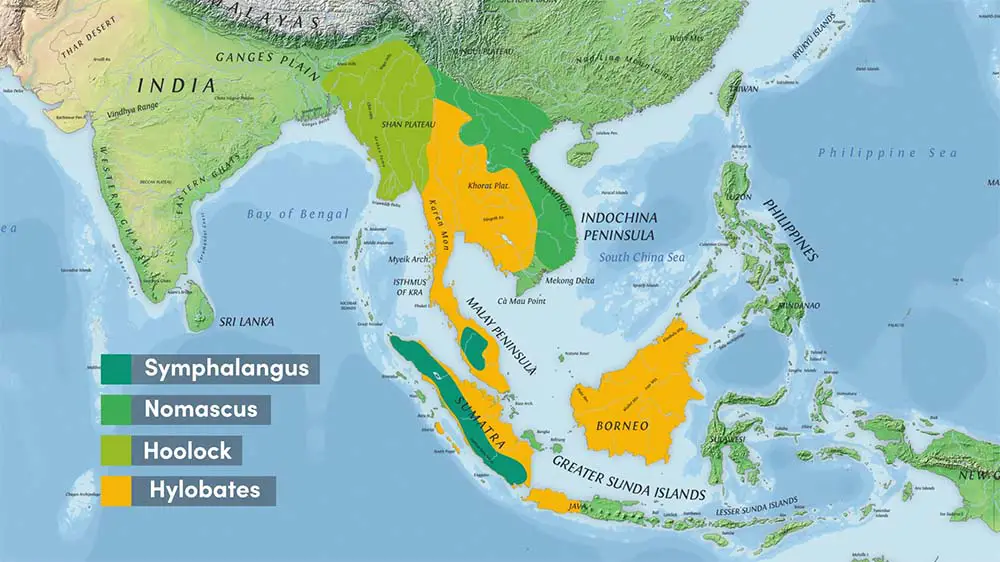
Orangutans are the most distant of the great apes from humans and although they are found in the same family as gorillas and chimpanzees, they are contained within their own subfamily, Ponginae, which contains a single genus, Pongo. Bornean and Sumatran orangutans are found on their respective islands with a 3rd species identified in 2017, the Tapanuli orangutan, being found to the south of the Sumatran population.
All three of these species are critically endangered. The Bornean orangutan has the highest numbers, with a population of around 100,000 but this drops off significantly on the other side of the Javan sea with the Sumatran orangutan down to just 7,500 individuals and the Tapanuli orangutan down below 800.
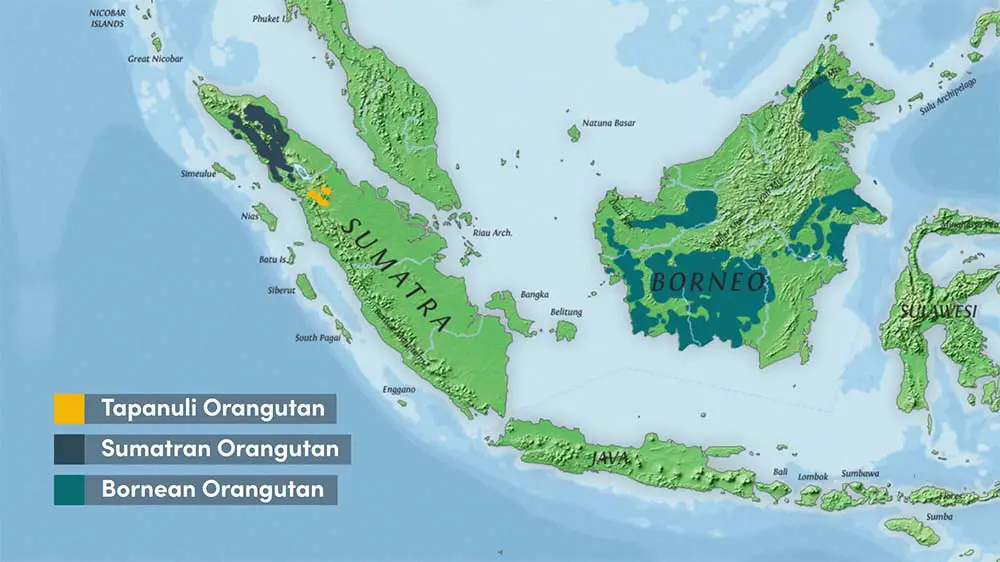
Gorillas are the first of the apes we’ll discuss in the subfamily, Homininae. There are two species found in separate locations on either side of Central Africa, divided by the Congo river and its tributaries. Each of these species is split further, geographically, by their respective subspecies; the Cross River gorilla, the western lowland gorilla, the eastern lowland gorilla and the mountain gorilla.
Habitat destruction and the bushmeat trade also pose a threat to gorillas, in addition to being hunted for game. Both species of gorilla are critically endangered; the most at threat is the eastern gorilla, whose combined numbers are estimated to be around 5,000, with just 1,000 mountain gorillas remaining. On the other side of the continent, there are estimated to be around 100k western gorillas but the Cross River gorilla is the subspecies most at risk with an estimated 200-300 individuals remaining.
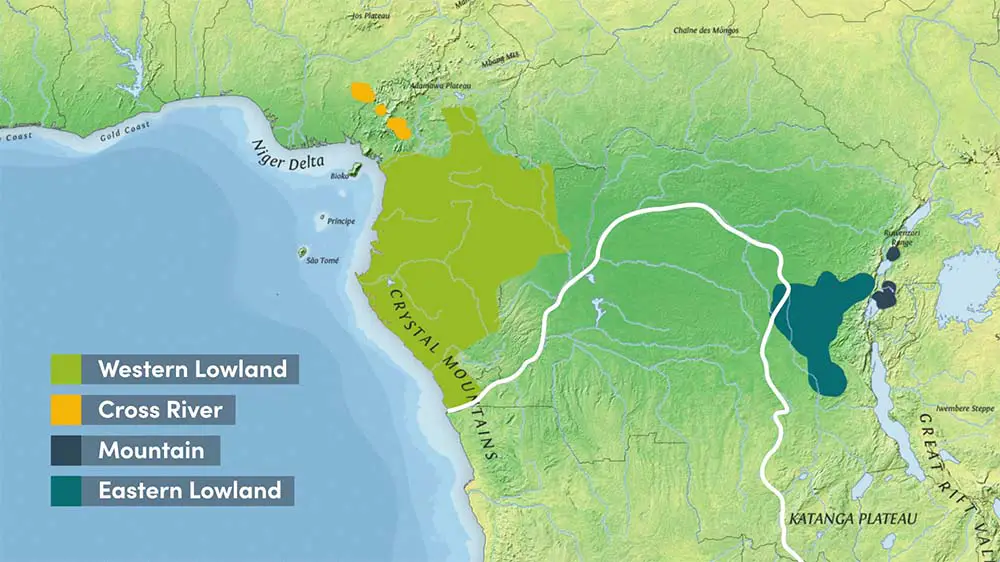
Finally, the genus Pan is found in the same tribe as humans and contains two species; the bonobo is found to the south of the river Congo in the heart of the DRC and the common chimpanzee, which is located on the northern side of the river and, geographically, is also split further by its 4 subspecies found as far west as Senegal and as far east as Tanzania.
While the 150 – 250 thousand chimpanzees found in the wild is significantly higher than the 10 – 50 thousand bonobos, both of these species are classified as endangered with threats coming from habitat loss and hunting for meat.
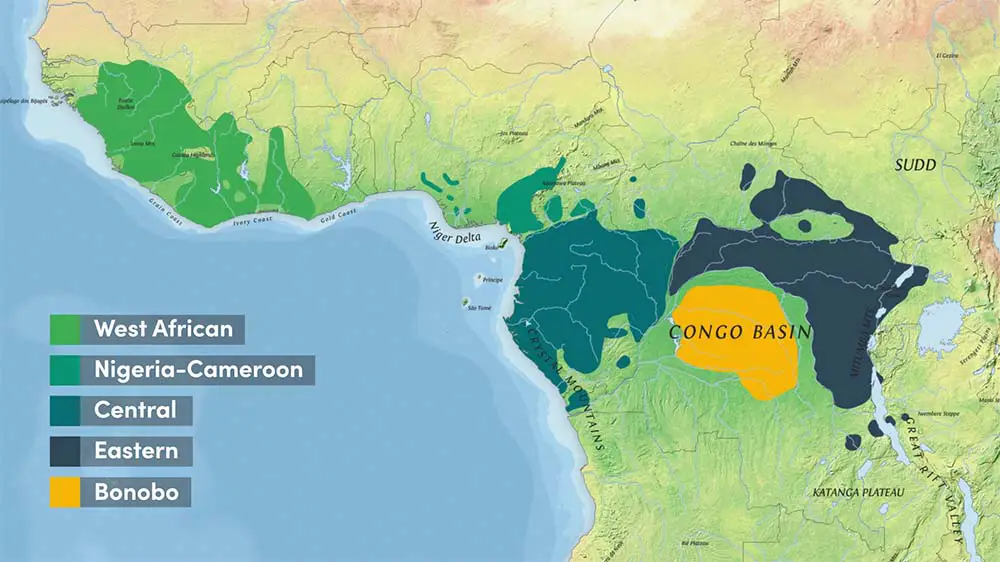
Physical Characteristics
The smallest of these animals are gibbons, which thanks to their high number of species, are also the most diverse in appearance. These apes have exceptionally long arms—sometimes up to 2.6 times the length of their bodies—that help them navigate their arboreal habitat with ease.
The Siamang is contained in its own monotypic genus and, physically, is quite different to other gibbons. At up to 26.5 lb / 12 kg it is the largest species and is also fairly easy to distinguish visually with its thick black fur surrounding a nearly hairless, light grey face and a large throat sac they use to produce loud vocalisations. Interestingly, their Latin name Symphalangus syndactylus refers to the fused 2nd and 3rd toes on their feet, similar to those of a koala.
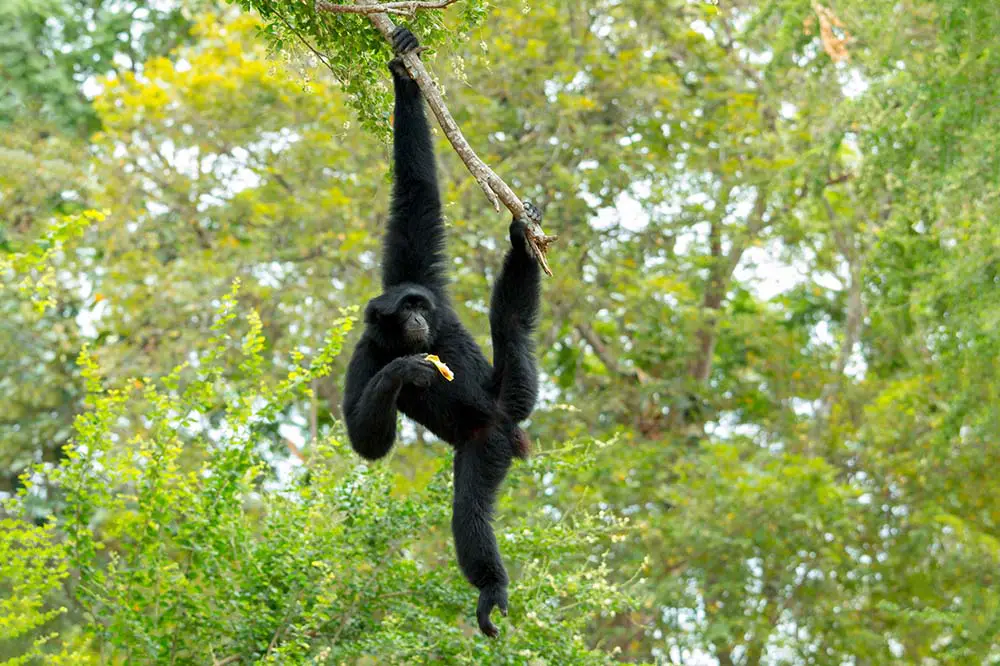
There are many examples of gibbons that exhibit sexual dichromatism, where males display a different colour to their female counterparts. The Lar or White-handed gibbon is one such species and belongs to the Hylobates genus, also referred to as the dwarf gibbons, whose members usually weigh between 8.8 lb – 17.6 lb / 4 to 8 kg. Both males, who are black and females, who are cream or buff, have a white circle around the face. This genus also contains the silvery gibbon, which exhibits a beautiful silvery-grey pelage.
Other species include the northern white-cheeked gibbon, which don’t look too dissimilar to the Lar gibbon but are from the Nomascus genus. Males are black with white fur around their cheeks and females are buff with a black patch on the top of their heads. Finally, members of the hoolock genus are also quite unique, exhibiting a white brow across the forehead.
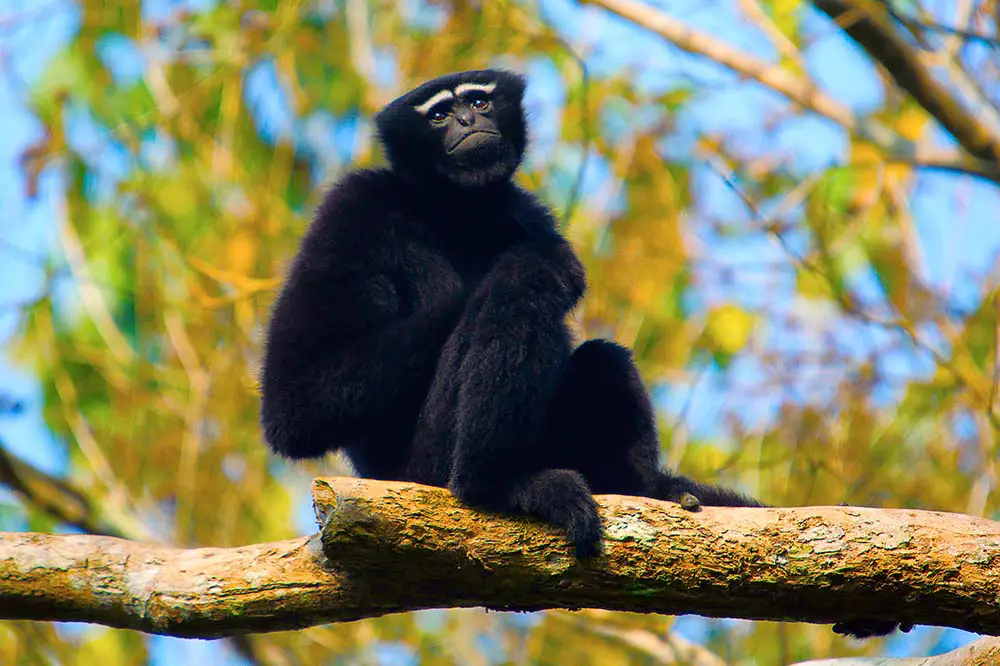
Like gibbons, orangutans also have bodies built for the trees; their enormous arm span can measure up to 7ft long, which when combined with their incredibly flexible legs and opposable thumbs on all four extremities, allows them to move gracefully through the trees.
Orangutans display sexual dimorphism; adult males are around twice the size of females and usually weigh around 200 lb / 91 kg but can be found closer to 300 lb / 136 kg. They measure around 4-5 ft (1.2m – 1.5m) in height, which is roughly the same as a chimpanzee but shorter than a gorilla.
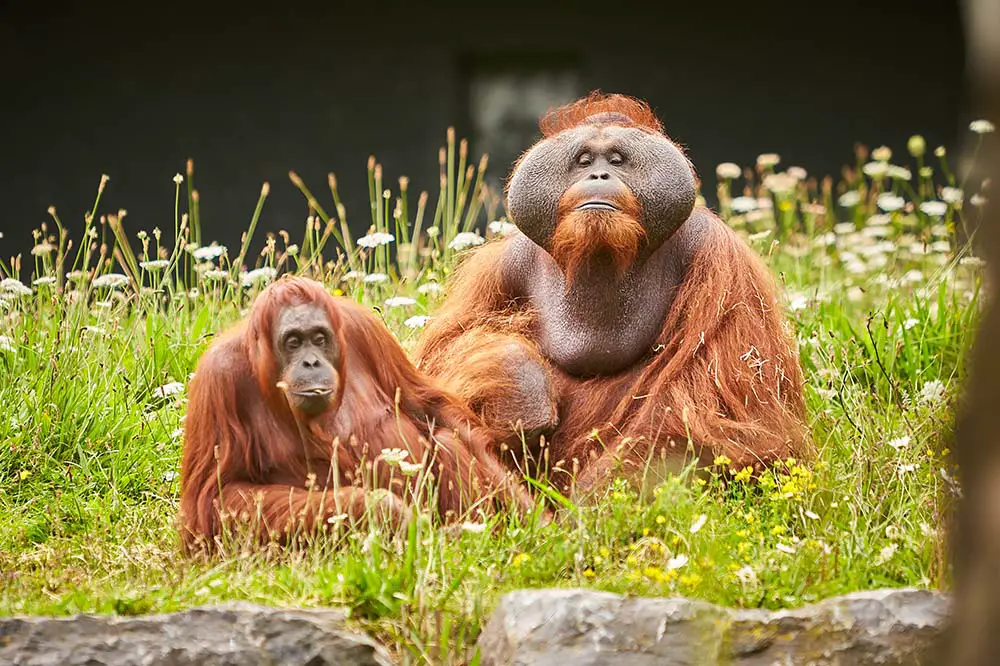
Males also develop large cheek pads as they age, which are through to be associated with increased levels of testosterone and appeal to the opposite sex, with females more often mating with adult males who have the cheek pads over subadult males who have yet to develop them.
Their bright orange fur is, oddly enough, thought to be for camouflage; in direct sunlight, it is distinct and obvious but in the shadows of the forest canopy their dark tan skin absorbs the light and makes orangutans difficult to see.
Bornean orangutans can be distinguished by the white hairs on their face and longer fur, including their beards, as well as exhibiting a more slender build. Tapanuli orangutans differ from other species by their dental structure and the structure of the skull, including but not limited to a shallower face depth.
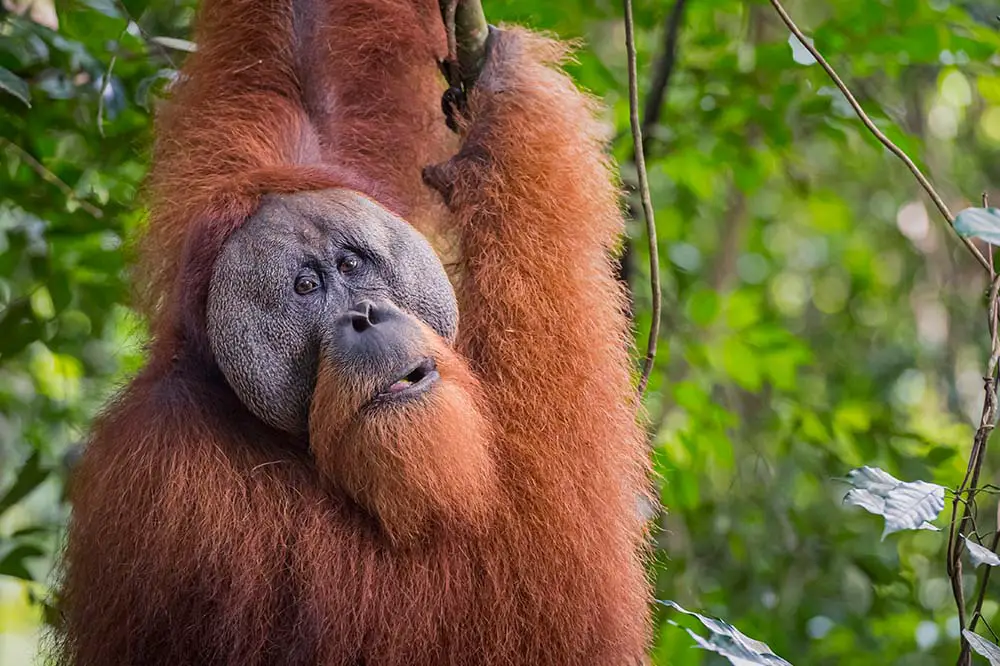
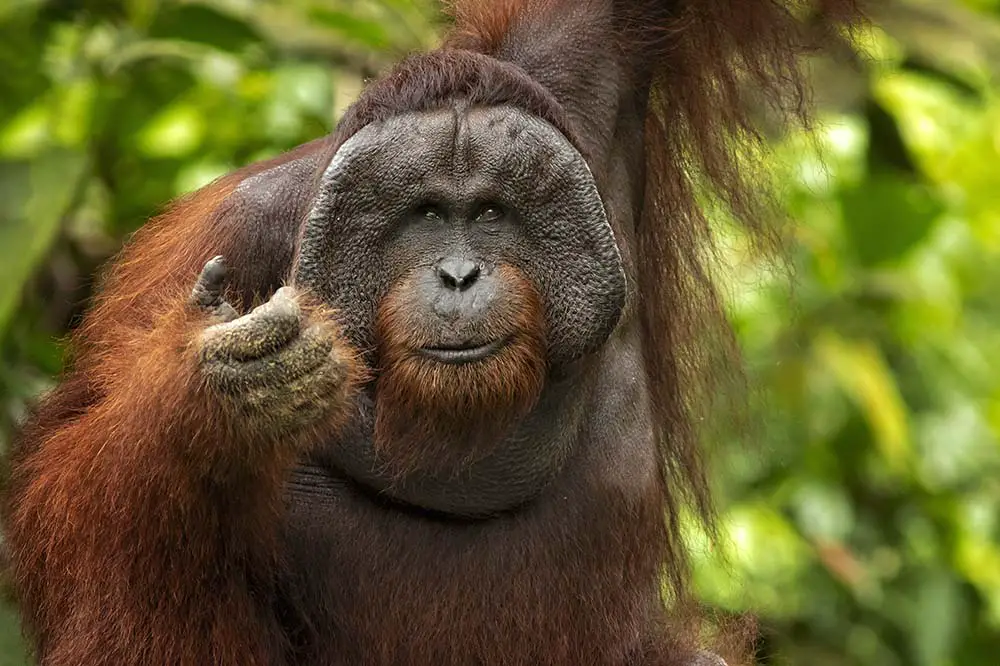
Left: Sumatran Male / Shutterstock & Right: Bornean Male / Shutterstock
Even bigger than orangutans, Gorillas are the largest of the apes with adult males usually topping out around 5.5 ft tall (1.7m) and close to 500lbs (485 lbs / 220kg) with the largest specimens recorded at well over 6 ft (1.8 m). They are also sexually dimorphic; females measure just under 5 ft (1.5 m) in height but are half the weight due to the stocky build of the adult males who are referred to as silverbacks, a reference to the grey or silver hairs they develop on their backs as they age.
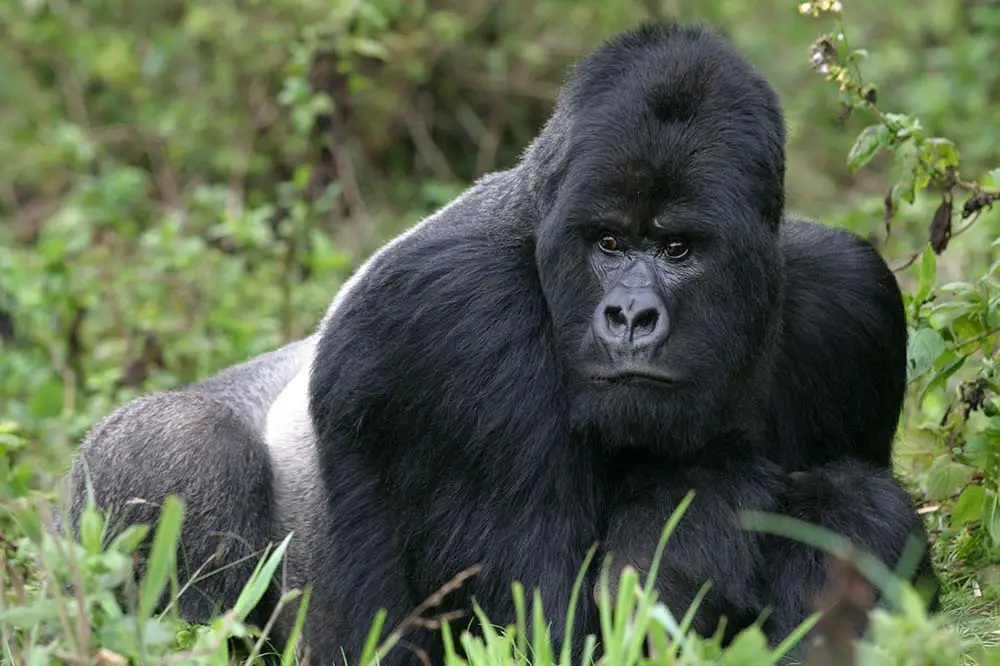
Gorillas also have opposable digits on their hands and feet, allowing them to manipulate objects with all four extremities. Although their arms are proportionately shorter than those of orangutans and gibbons, they are still 15-20% longer than their legs.
Eastern gorillas are slightly larger than their western counterparts and have darker longer fur. Specifically, the western lowland gorilla is often sighted as the smallest of the four subspecies and the eastern lowland gorilla as the largest. Mountain gorillas also have the longest hair, which they use to keep warm at higher altitudes and, like the Tapanui orangutan, the Cross River gorilla exhibits noticeable differences in skull and dental structure.
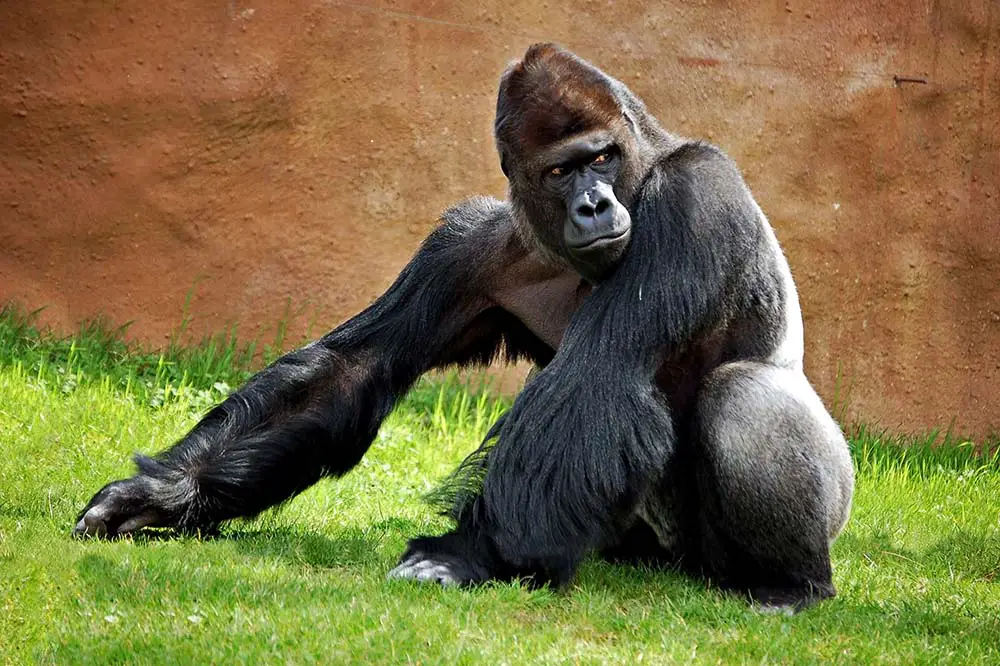
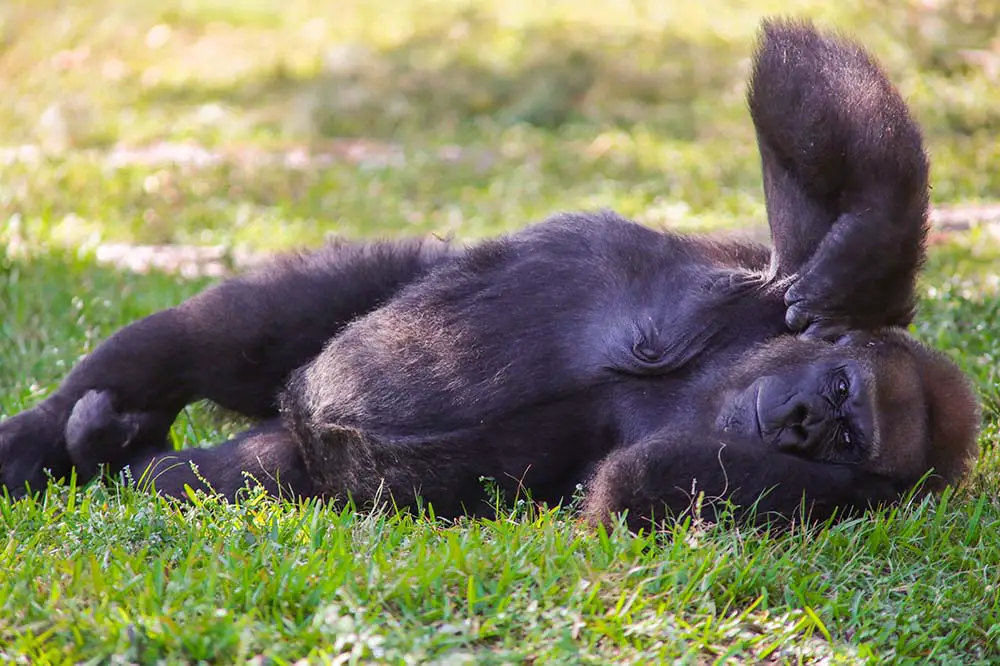
Left: Silverback with long arms / Shutterstock & Right: Cross River Gorilla / Shutterstock
Chimps and bonobos are the smallest of the great apes but at 4 – 5ft (1.2 – 1.5m) and no more than 130 lb (59 kg) are much larger than gibbons. Chimpanzees tend to be slightly larger than bonobos, who were referred to as ‘pygmy chimps’ until they were found to be a separate species, and have a more stocky build, with shorter legs but wider chests.
While chimps and bonobos are sexually dimorphic, this is to a much lesser extent than the other great apes; the size difference between males and females is a ratio of roughly 1.3, which, for the sake of comparison, is still greater than humans, who are closer to 1.15.
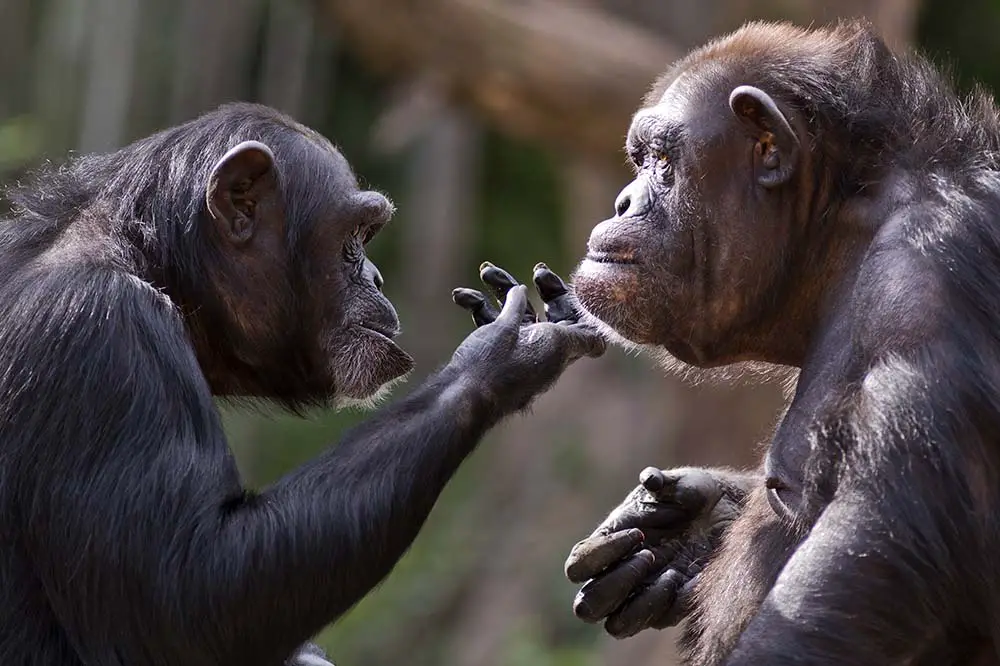
Both chimps and bonobos have long black hair that covers their bodies but one of the most interesting differences between species is the appearance of their young. Chimpanzees are born with white skin on their faces and ears, which darkens with age, whereas bonobos are born with this dark skin. As both species age, some of their hair also tends to turn grey and the forehead can also become bald.
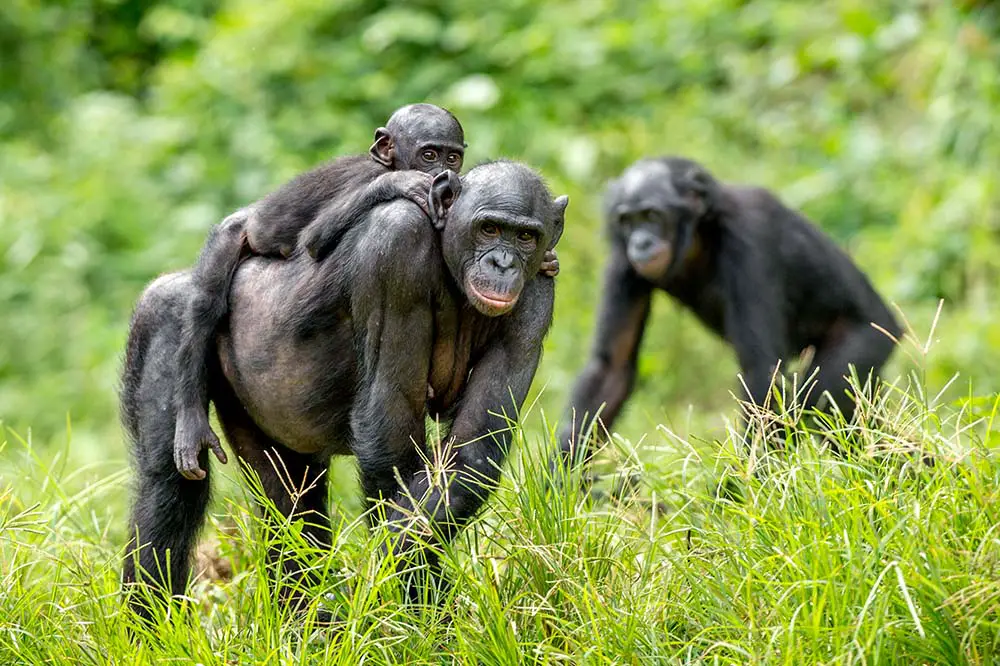
Ecology, Diet & Movement
In terms of ecology, bonobos are found only in lowland tropical forests whereas the habitat of the chimpanzee extends into grassland and woodland areas. Both species use arboreal and terrestrial locomotion to move around their territory. Each night, they make a nest in the trees before rising early to find breakfast, which ideally is made up of nutritious fruits. Unlike some of the other apes, chimps will cover long distances on the ground where they use a type of locomotion referred to as knuckle-walking—bearing their weight on the knuckles of their hands—and are also able to move in an upright posture.
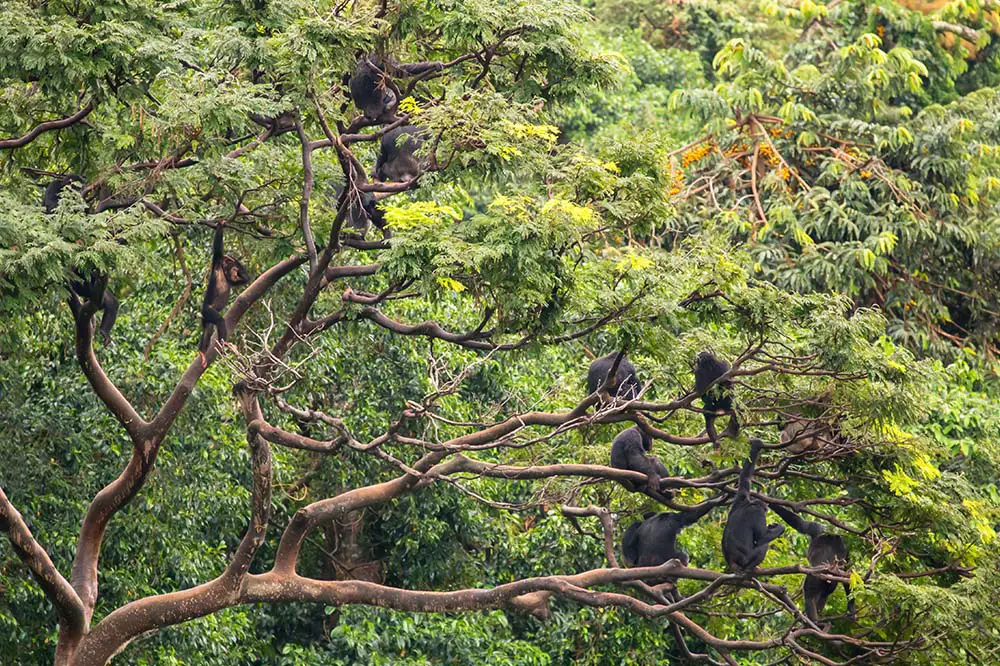
The diet of both chimpanzees and bonobos is made up mostly of vegetation such as fruits, leaves, roots and seeds, however, both species are omnivores and, although a lot less frequently, will also consume invertebrates and mammals such as duiker—a small antelope. Chimpanzees eat more meat than bonobos and have been observed pinching eggs and chicks as well as hunting pigs and even other primates such as colobus monkeys.
Both species typically consume their food in the trees and do so at two times during the day; once in the morning followed by a midday rest and then a longer session of eating follows in the afternoon and evening. Tool usage is a particularly interesting trait that was first observed by Jane Goodall in the 1960s at Gombe Stream Game Reserve in Tanzania. These primates use sticks to fish termites out of their mounds and leave sponges to soak up water.
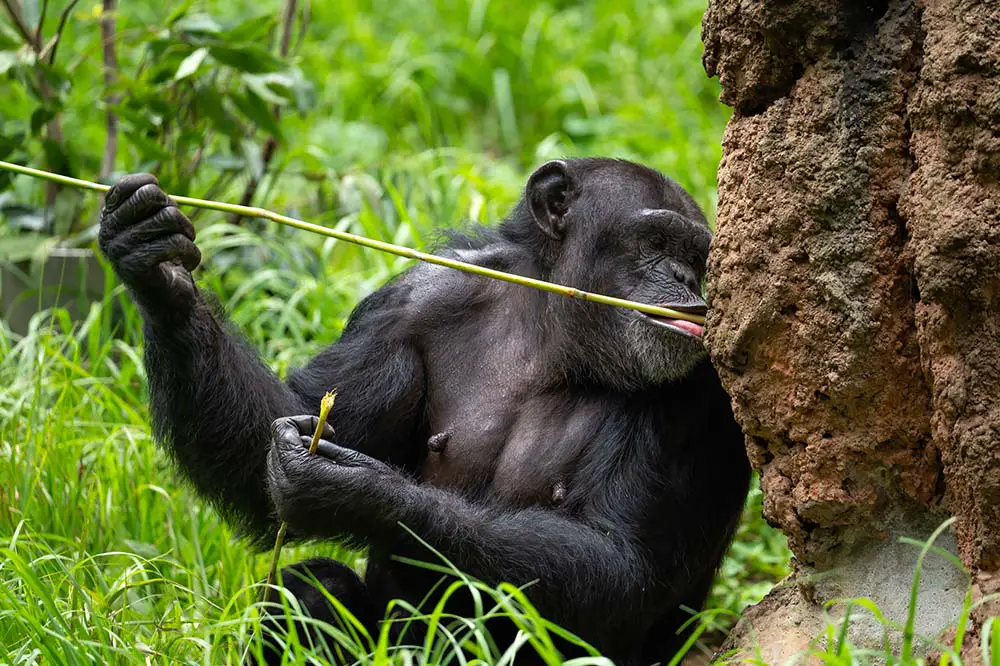
Gorillas are also found in the tropical forests of Central Africa but the elevation at which they live varies by subspecies. The western lowland gorilla, which commands the largest range of any subspecies, lives at the lowest average altitude, mostly preferring lowland tropical forests whereas the Cross River gorilla lives in the mountainous border region between Cameroon and Nigeria. Likewise, on the other side of the Congo, the eastern lowland gorilla lives in lowland tropical forests but can also be found at higher altitudes, and as you might expect, the mountain gorilla is found at the highest elevations up to 14,100 ft / 4,300 m.
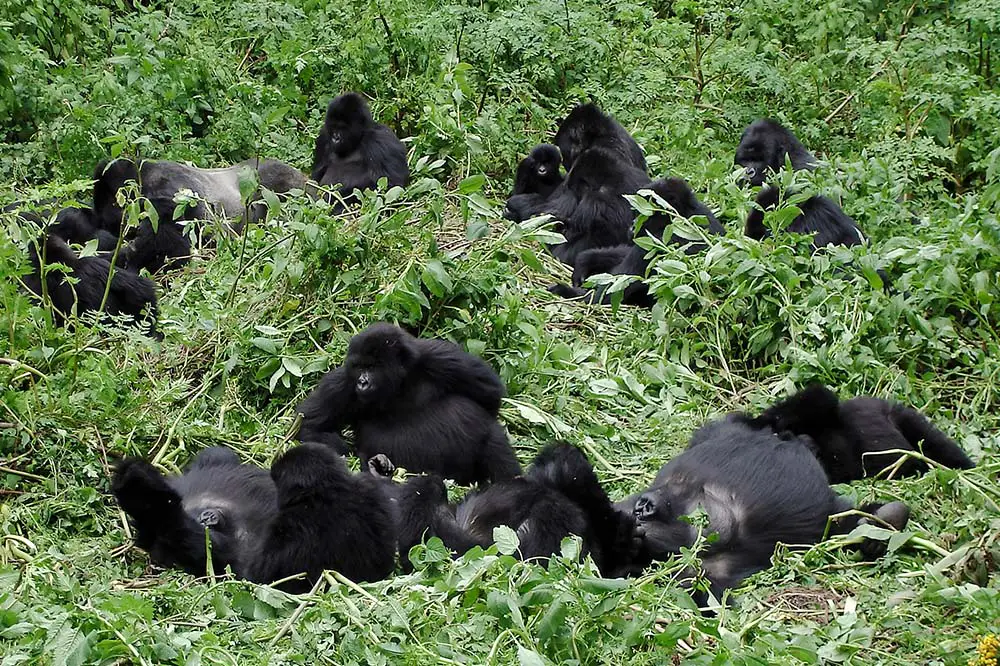
The diet of a gorilla is more strictly vegetarian than that of a chimp or bonobo; they mostly gorge on leaves, stalks and fruit although they will also feast on ants and termites as well as their larvae. The makeup of their diet depends on subspecies, for example, fruit trees and termites are much more common in lowland tropical forests and thus are consumed a lot more by western lowland gorillas than they are by mountain gorillas who eat larger amounts of leaves, stems and other similar vegetation. Like chimps and bonobos, they eat in two intervals per day and a large silverback can consume up to 60 lb (27 kg) in one day.
Although gorillas can and do climb trees, they are mostly terrestrial and, like chimps, will move around using knuckle-walking. Females and young climb more than adult males whose weight is simply not supported by the canopy. As such, gorillas will sleep in nests in the trees or on the ground on a bed of foliage.
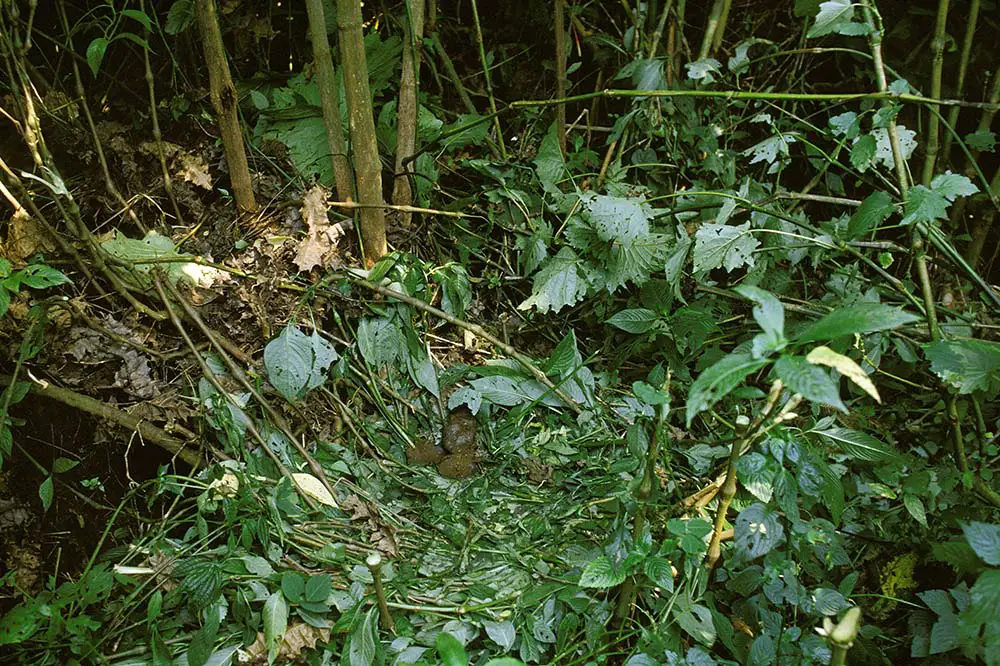
Moving to Asia, the ecological preferences of the orangutan are much simpler than that of the gorilla; all three species live in the lush tropical forests of Borneo and Sumatra and none of them ventures above 4,600 ft (1,500 m). Orangutans spend the vast majority of their time in trees where they build their nests to sleep and move about with ease thanks to their long arms and hook-like hands. They can often be seen high up in the forest canopy, which is quite incredible for such a large ape. On the occasion they do spend time on the forest floor, they do so on all fours but usually do not use knuckle-walking like gorillas and chimps.
Like the western lowland gorilla, fruit makes up a large portion of their diet at around 50%, which is supplemented with other types of vegetation in addition to small amounts of insects such as ants and termites. Very occasionally, orangutans have been observed eating meat when fruit is scarce, specifically their fellow primates, slow lorises. Like chimps and gorillas, orangutans have also been observed using sticks as tools to extract insects from trees as well as using leaves as umbrellas when it rains!
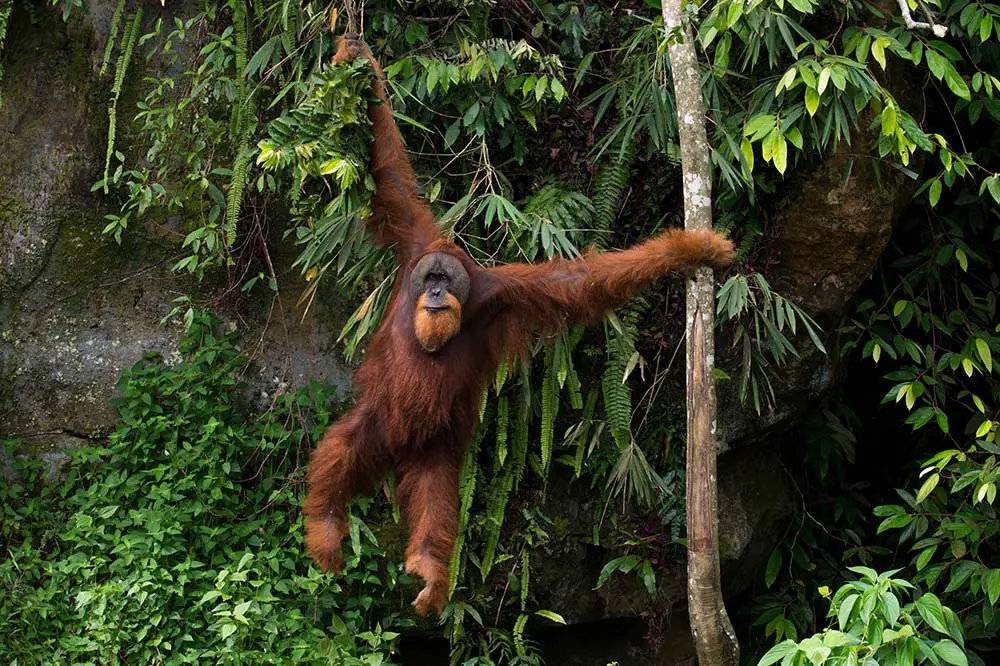
Gibbons are also thought of as arboreal, in fact, hylobates, one of the four genera can be translated to either “forest walker” or “dweller in the trees”. They are perhaps the most efficient ape in the trees and use their long arms and flexible shoulder joints to brachiate through the forest. On the ground, gibbons walk in a fully upright posture and will also use their long arms to balance when walking along a branch.
All species are found in various types of tropical forests, however, the altitude at which they are found varies by species. The northern white-cheeked gibbon is found at low altitudes of between 985 – 1970 ft (300 – 600 m) in Laos, Vietnam and Southern China. The Black-crested gibbon, which is very similar in appearance, is found at higher elevations between 1805 – 8822 ft (550 – 2690 m). Unlike great apes, gibbons choose to sleep on open branches and rarely sleep in the same place more than once to reduce predation by animals such as pythons or birds of prey.
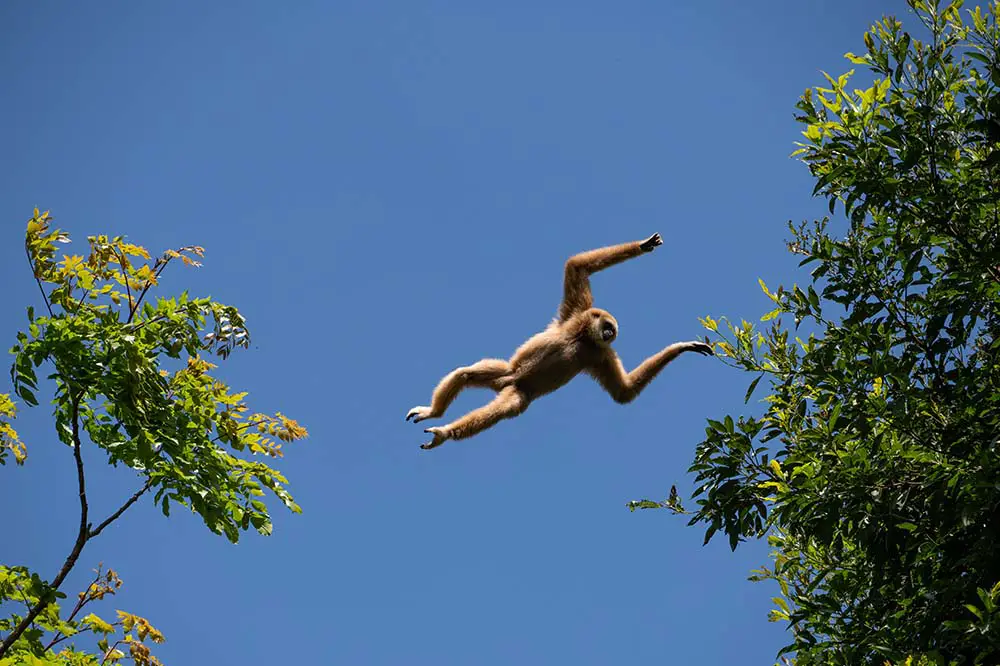
They are also thought of as frugivorous, with ripe fruit often making up a large portion of their diet, which they will supplement with leaves and other vegetation as well as insects and less frequently bird eggs. Of the fruits available, figs are a particularly popular food source; 26% of a pleated gibbon’s diet is made up of this nutritious fruit. Siamangs eat a higher proportion of leaves than any other gibbon, making up 40-50% of their diet.
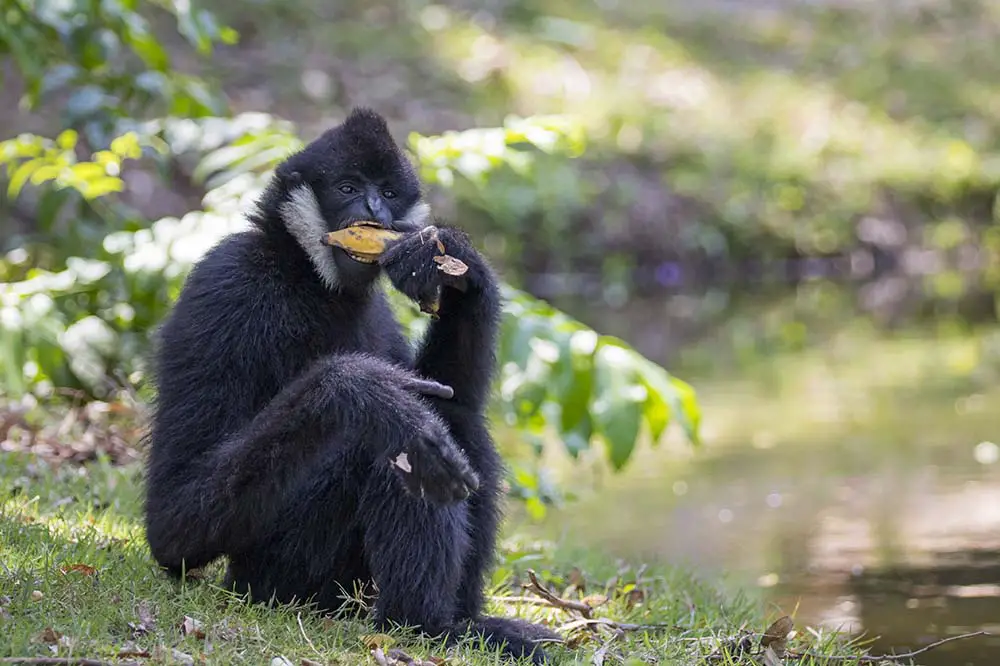
Behaviour
Chimps and bonobos have by far the largest group structure and territory; they live in communities of between 30-100 but spend most of their time split into smaller groups known as parties with whom they forage for food. Chimpanzee communities are led by a dominant male and a coalition of allied males who are notoriously violent and use aggression to assert their dominance. Their territory ranges from 5 sq km (1.9 sq mi) in the forest to 500 sq km (193 sq mi) on the savanna. Bonobo communities on the other hand are female-dominated and are thought of as more peaceful societies with female members controlling the aggression of males, often with intercourse. The group size of bonobos is roughly the same but the territory is limited to just under 30 sq km (11.6 sq mi) as they are found only in tropical forests.
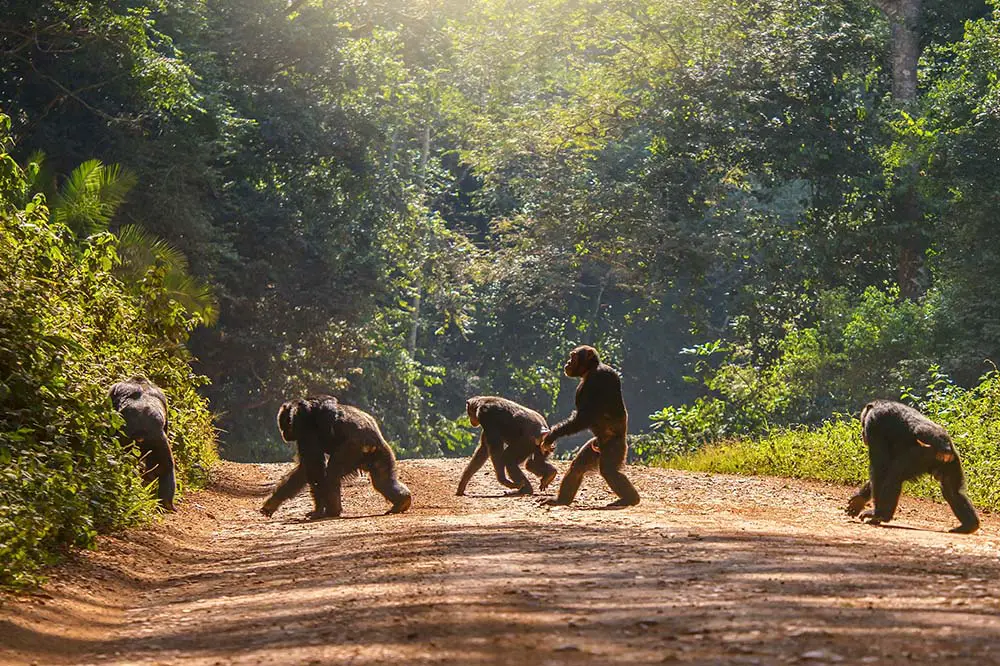
Intergroup relationships are quite different between chimps and bonobos. Chimpanzees are hostile and aggressive while defending their territory while bonobos have been observed sharing food with other communities as well as spending time with other groups.
Grooming is an important part of life in the pan genus and is used to bond with other members. Both species use a collection of gestures and facial expressions to communicate face to face and have a repertoire of vocalisations to do so over both long and short distances.
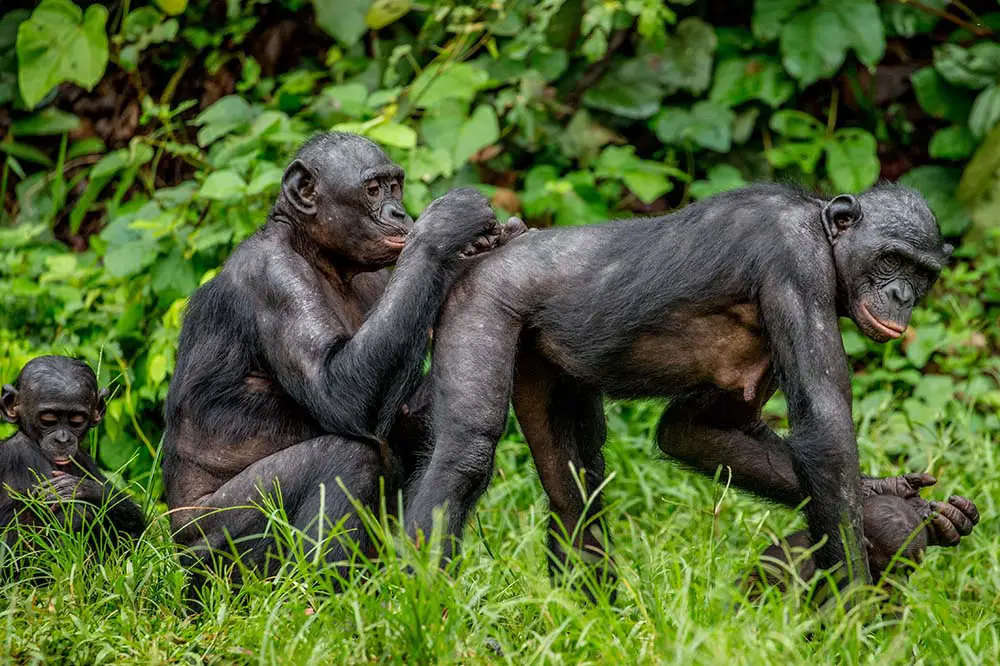
A group of gorillas is known as a troop and are smaller than chimpanzee communities at between 6 to 30 individuals. Troops consist of a dominant silverback male and several adult females with their offspring. Eastern gorilla troops are usually larger than that of the western species and can accommodate multiple males who are closely related. Troops of mountain gorillas in particular have been known to support up to 8 silverbacks. Their territory is also smaller than that of a chimpanzee community at between 2 to 40 sq km (0.8 – 15.5 sq mi).
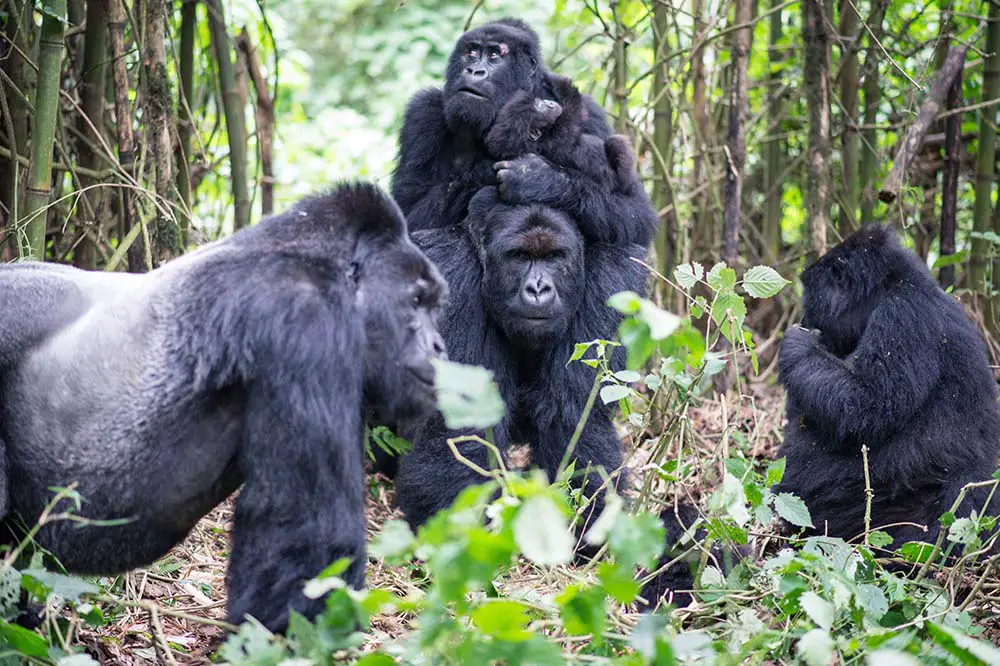
Grooming plays less of a role in gorilla societies than it does in that of chimps and bonobos, nevertheless, it does take place and is also used to strengthen bonds between individuals and usually occurs between males and females or females with their young.
Gorillas are often portrayed as aggressive creatures in popular culture but they are reserved by nature and silverbacks will usually only display aggression in the form of roaring and chest beating when defending other troop members or maintaining dominance within the troop.
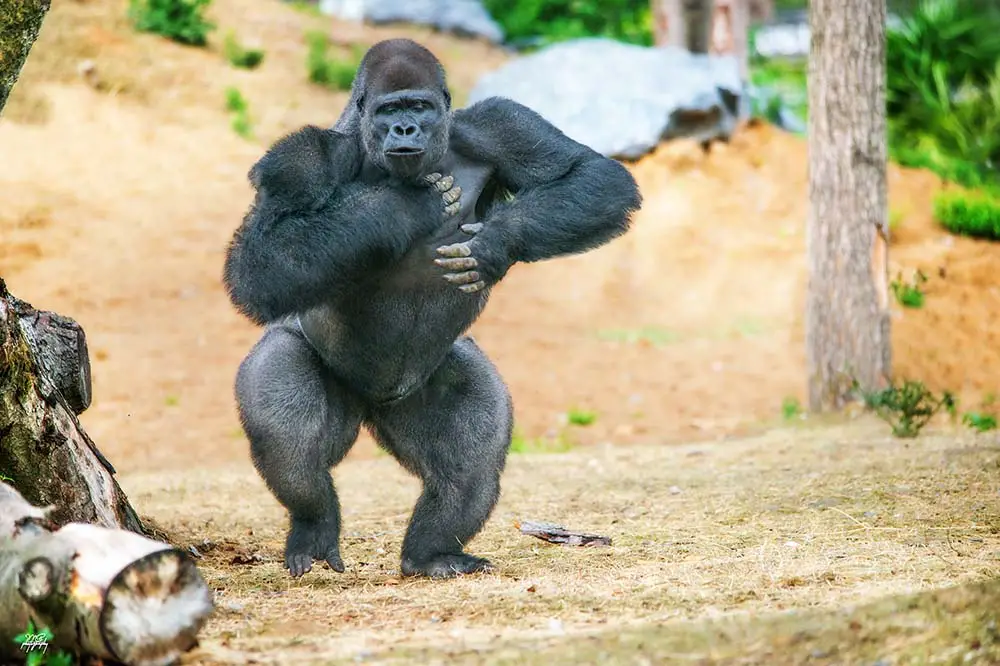
This social group behaviour is not mirrored by Asian apes; Orangutans are mostly thought of as solitary, especially adult males who roam the forest on their own and will usually only spend time with a mating female. Females are more social than males, travelling with their offspring and coming together to feed with other adults in their range when there is an abundance of fruit. The territory of a male orangutan is around the same as a gorilla troop at up to 40 sq km (15.5 sq mi) and will overlap with those of multiple females whose ranges are smaller at around 9 sq km (3.5 sq mi). Like gorillas, orangutans are thought of as placid and confrontation usually only occurs between adult males competing for females or territory.
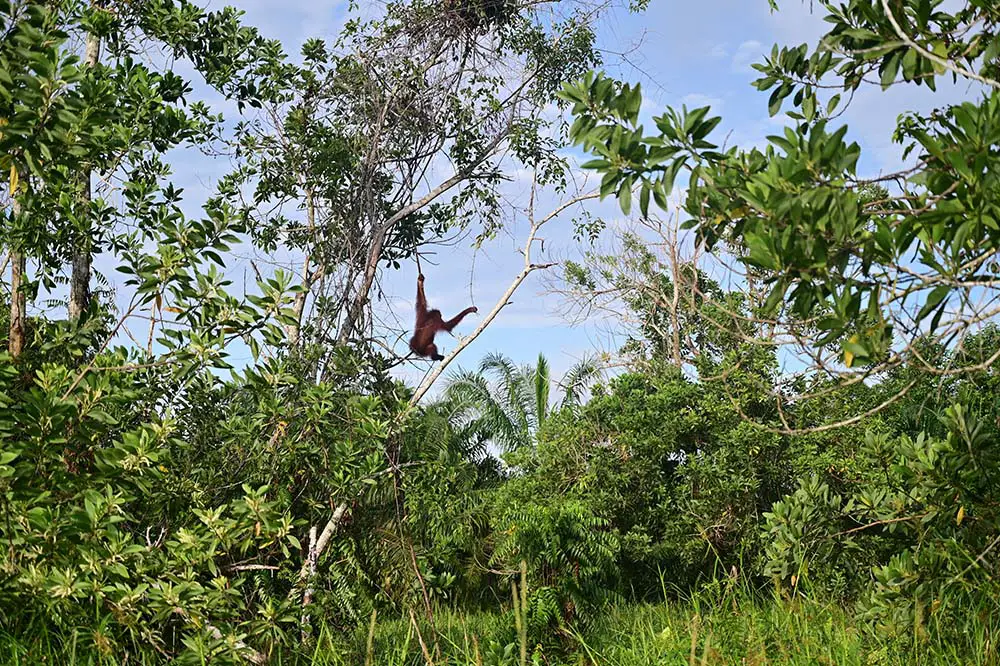
Orangutans use both verbal and non-verbal communication. The latter is used more often for long-distance signalling, in particular, a “long call” is used by males both to signal their presence to other males and also to attract females. A wide range of gestures are commonly used face to face, however, as the most solitary of the great apes, the extent to which these have been studied in the wild is much less.
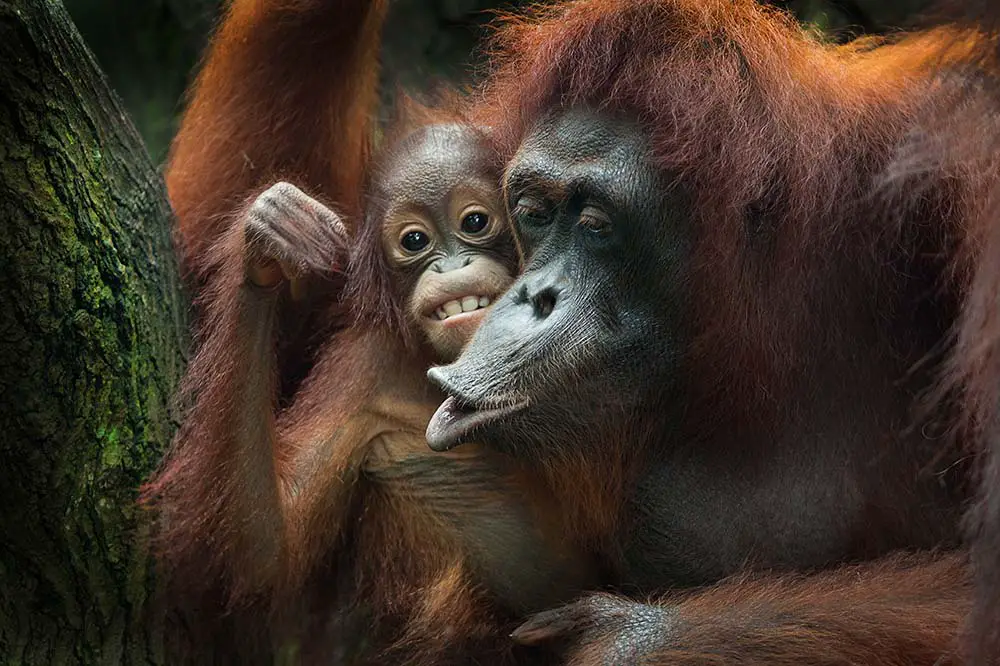
Although gibbons are the least closely related apes to humans, they have the most similar social structure found in family groups made up of a monogamous mating pair and their immature offspring. Territory size is quite small, usually between 0.1 to 0.5 sq km (0.04 – 0.19 sq mi). The Hainan black crested gibbon has the largest territory of any gibbon species at 2 to 5 sq km (0.8 – 1.9 sq mi).
Unfortunately, gibbons are the least studied of the ape species however, they also have one of the most interesting and heartwarming forms of communication. The male and female will sing a duet known as the “great call” used to mark their territory which is often joined by their young
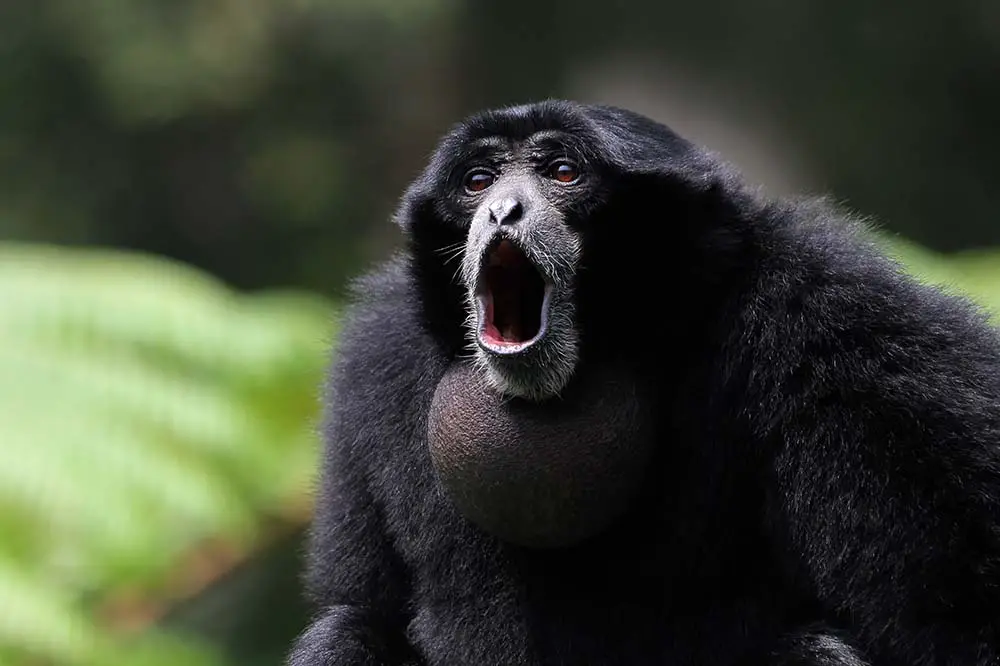
Sources
Chimpanzee Breakfast, Chimpanzee Diet, Chimps vs Bonobos, Chimp Social Hierarchy, Chimp Bonobo Comparison, Chimp Facts, Bonobo Communities, Chimpanzee Baby Care, Gorilla Social Groups, Gorilla Social Structure, Gorilla Species, Gorilla Diet, Gorilla Social Bonding, Orangutan ecology, Orangutan colour, Tapanuli Orangutan Morphology, Orangutan social behaviour, Orangutan territory, Orangutan breeding, Orangutan communication, Orangutan tool usage, Gibbon social structure, Nuclear Families, Gibbon reproduction, Gibbon sleeping, Encyclopaedia Britannica, Animal Diversity, National Geographic, WWF, IUCN Red List & Wikipedia.
